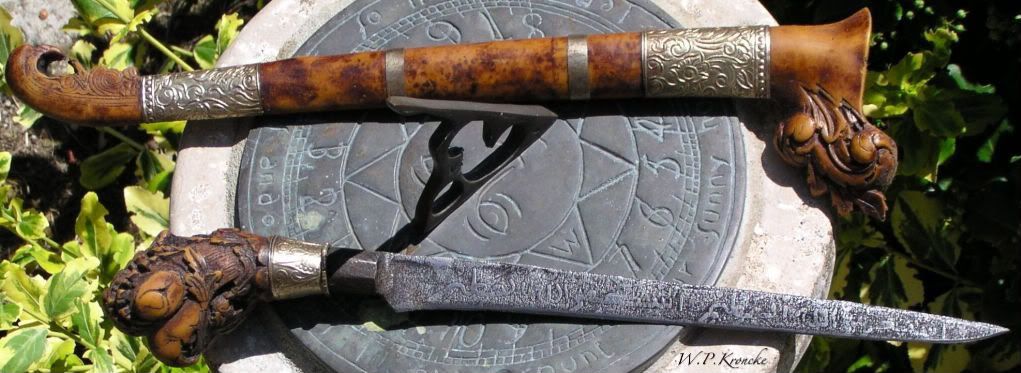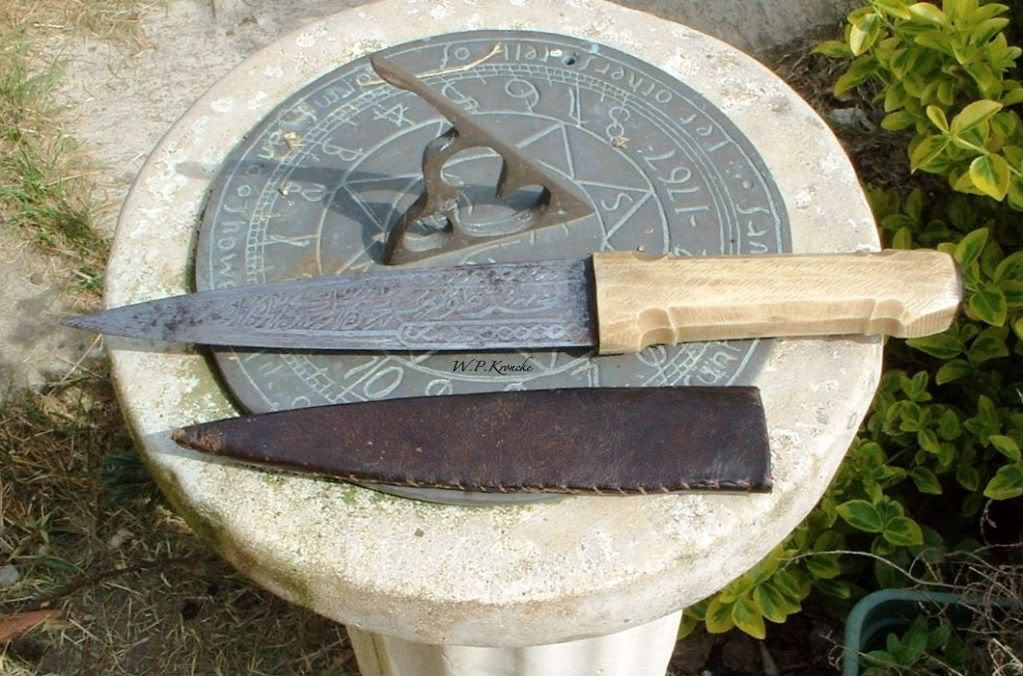
 |
|
|||||||
 |
|
|
Thread Tools | Search this Thread | Display Modes |
|
|
#1 |
|
Arms Historian
Join Date: Dec 2004
Location: Route 66
Posts: 9,739
|
On the 'haladie' thread we have entered into what has proven to be a fascinating subtopic, and Tim suggested perhaps a separate thread would be useful in recognizing and how widespread the use of this distinct calligraphy might be.
We know that thuluth is typically associated with Sudanese weapons, particularly Mahdist kaskaras and often sundry other weapons of the period, but was it used elsewhere? I have understood that as a form it seems to have developed from naskh with the Mamluks, but did its use expand to other areas on weapons? It would be very useful to see differences in the types of script used on inscriptions of Islamic arms and armour. Also, I have often heard that thuluth was often essentially unintelligible, and used on Mahdist weapons simply to imply imbued power to illiterate native warriors....however, in many cases the dramatically applied motif was actually repeated phrases from other notations I have seen. |
|
|

|
|
|
#2 |
|
Member
Join Date: Oct 2007
Posts: 2,818
|
No help here Jim but I can add this image for further discussion about the diverse styles of weapons used that carried this script.
Gav |
|
|

|
|
|
#3 |
|
Arms Historian
Join Date: Dec 2004
Location: Route 66
Posts: 9,739
|
Thanks so much Gav! Thats what I was looking for, good examples, and this really presents a quandry with this....what in the world is a Sudanese weapon doing with an obviously Indian hilt????
Last April we discussed another of these anomalies with a brass tulwar hilt and a Sudanese type blade described as a 'kirach', posted by Valjhun. (attached below) I have seen these curious tulwar type kaskaras a number of times, but not in any significant number. There was of course distinct connections in trade between India and the Sudan, and Indian forces were with the British at Suakin in 1885, but it would not seem any of them would have had Mahdist blades on thier weapons. There have been firangi blades mounted on a few kaskaras.....but it would seem more likely that these Indian hilted examples would have been the product of innovative armourers in Sudan using Indian hilts. I am wondering if any weapons attributed to India have thuluth motif. All the best, Jim Last edited by Jim McDougall; 18th July 2010 at 02:20 AM. |
|
|

|
|
|
#4 |
|
Member
Join Date: Dec 2004
Location: What is still UK
Posts: 5,739
|
To keep a more narrow focus lets just stick to etched thuluth where ever from. I have seen some on Indonesia weapons.
These are the three examples I have. I am not an expert but I thick it is possible to see three diferent styles, certainly two. Are they indicative of differnt regions? Clearly different manufatures. Crocodle skin in not a pointer as the Niger has crocs. |
|
|

|
|
|
#5 |
|
Member
Join Date: Dec 2004
Posts: 1,247
|
Hi Jim,
Since I'm just learning about this, does the thuluth name cover the shape of the characters or the method of etching? Or both? To me, it looks like the figure and ground are effectively reversed from "normal" weapon etching. "Normally," characters are incised in blades, and if etched, the etcher coats the weapon with wax (or similar) and scratches the characters in the wax. Here it looks reversed, in that the figures appear to be written in crayon (okay, written with wax) and the blade is etched around them. Can you help me understand a bit better? Best, F |
|
|

|
|
|
#6 |
|
Arms Historian
Join Date: Dec 2004
Location: Route 66
Posts: 9,739
|
I agree Tim, good idea to keep the focus on the thuluth form and look into various places it is known to have been used. In looking into Yucel's book, he notes thuluth in use in Ottoman parlance about 16th century and apparantly in Mamluk context, most likely Syria, but some of these early swords were of Egyptian make,
It would be interesting to see Indonesian examples of thuluth, and it seems that I might have seen something like this in an article by Cato. I can only hope that the guys collecting those areas might see this thread and maybe offer some help. Well made point on the crocodile skin too. There certainly were crocodiles in the Niger and the use of crocodile hide was used in certain cases in West Africa in some of the secret societies. The use of the crocodile hide on weapons to me seems situated mostly in Sudan, but in singular cases it would be possible to the west I suppose. Most of what Ive seen is armor type regalia, along with pangolin hide, rather than on weapons. Fearn , actually I'm right with you, and glad that Tim suggested this thread as I must admit I've never really understood the differences or application of this type script. While I have known what it was since my first kaskara, back about 30 or so years ago, I only knew of it as huge script that I thought was simply decorative motif. Now it seems that in many cases it is quite legible and derived from other, earlier forms like naskh and Kufic. I'll be doing some more studying of course, and hope others who know this stuff already will come in to share some knowledge  All best regards, Jim Last edited by Jim McDougall; 18th July 2010 at 10:26 PM. Reason: adding attachments |
|
|

|
|
|
#7 |
|
Arms Historian
Join Date: Dec 2004
Location: Route 66
Posts: 9,739
|
I found some information, though it does not specify what type of acid was used. It seems that this etching work was done primarily in the Mahdist arsenals at Omdurman.
The weapon was blue heat tempered or fire blued until the surface forms a thin layer of magnetite, upon which the blued surface has the design or in this case inscription , applied with a mastic resin resist material , then the acid is applied. The acid pits the exposed metal leaving a raised design where the resist was applied. When the kaskara (in this case) or weapon was finished, it was bright with dark blue etched writing. This must have been an incredibly dramatic appearance which would have deeply inspired the ansar who would wield these weapons. Naturally over time and wear, the inscription would become metallic as the bluing wore away, while the background of the blade would darken in contrast. This is my obviously lay interpretation of this process, and I would beg the indulgence of the metallurgists reading this  but I wanted to at least give what perspective I could to how this was done. but I wanted to at least give what perspective I could to how this was done.
|
|
|

|
|
|
#8 |
|
Member
Join Date: Mar 2006
Location: Room 101, Glos. UK
Posts: 4,150
|
one from a bit further east
 tumbuk lada with cockatoo head grip. similar inscription to the one in the style examples above. the raised letters are bright, the etched backgrounds are blackened. Last edited by kronckew; 19th July 2010 at 12:49 PM. |
|
|

|
|
|
#9 |
|
Arms Historian
Join Date: Dec 2004
Location: Route 66
Posts: 9,739
|
Outstanding Kronckew !!! Theres one, and great example. I wish I had that Cato article which I think was about Islamic swords of the Philippines and was in "Arts of Asia" years ago. It seems that there were inscriptions on a number of Moro weapons and perhaps thuluth might have been used.
Thank you so much for helping with this  All the best, Jim |
|
|

|
|
|
#10 |
|
Member
Join Date: Dec 2004
Location: What is still UK
Posts: 5,739
|
Thank you kronckew. Now there is an Indonesian weapon here I was expecting a swamping of interest, but so far still rather slow. Members have the weapons African or Indonesian and esle where. It is difficult to move forward without participation.
We have the members that can read this stuff. How do the readings differ? I made this last pic fit my monitor. |
|
|

|
|
|
#11 |
|
Member
Join Date: Mar 2006
Location: Room 101, Glos. UK
Posts: 4,150
|
back to omdurman...
 as another contrast |
|
|

|
 |
|
|